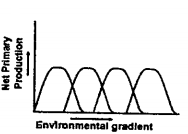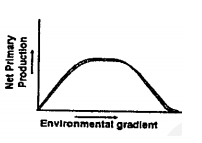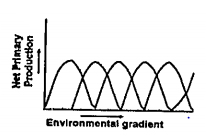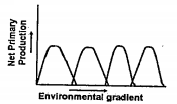 Multiple Choice Questions
Multiple Choice QuestionsBased on per molecule, which of the following gas has the most powerful greenhouse effect?
CO2
CH4
N2O
CFCs
A species has the following population characteristics:
(A) Reduction in population size ≥90% over the last years or 3 generations.
(B) Geographic range : extent of occurrence : < 100 km2 and Area of occupancy : < 10 km2
(C) Population size less than 50 matured individuals
(D) The probability of extinction in the wild is at least 50% within the next 10 years or 3 generations.
To which of the following categories the species will be assigned according to IUCN categorization of threatened species (version 3.1)?
endangered
vulnerable
critically endangered
extinct in the wild
At a given time, the age class distribution of a population was as shown in the figure:
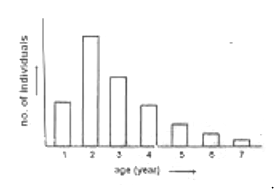
Which of the following can be inferred from the figure?
Age class 2 has a maximum fecundity.
Age class 2 has maximum survival.
Age class distribution is at equilibrium
Age class distribution is not at equilibrium.
While studying the diversity of 4 communities, 5 species and 50 individuals were recorded from each community. The number of individuals under each species was listed as mentioned in the following Table. In which of the following communities Pielou’s Evenness Index (e) will be 1?
| Community | Species 1 | Species 2 | Species 3 | Species 4 | Species 5 | |
| 1. | A | 20 | 8 | 7 | 5 | 10 |
| 2. | B | 10 | 10 | 10 | 10 | 10 |
| 3. | C | 10 | 12 | 10 | 8 | 10 |
| 4. | D | 1 | 1 | 1 | 1 | 46 |
Average annual precipitation and temperature are two important determinants of the world’s major biomes. Which of the following combinations is correct?
| Temperature precipitation | Biome |
| A. 25°C temperature and 255 cm precipitation | i. Temperate forest |
| B. 15°C temperature and 300 cm precipitation | ii. Savannah |
| C. 15°C temperature and 100 cm precipitation | iii. Temperate rain forest |
| D. 25°C temperature and 255 cm precipitation | iv. Tropical rain forest |
(A) – iv; (B) – iii; (C) – i; (D) – ii
(A) – iii; (B) – ii; (C) – iv; (D) – i
(A) – ii; (B) – i; (C) – iii; (D) – iv
(A) – i; (B) – iv; (C) – ii; (D) – iii
A researcher collected information from four forest areas using a sensor to assess their green cover. Observed average spectral values for each of the forests are given in the table below:
| Forest | Spectral value NIR | Spectral value VIS |
| A | 0.50 | 0.08 |
| B | 0.40 | 0.30 |
| C | 0.50 | 0.20 |
| D | 0.60 | 0.20 |
The forest green cover in the order of highest to lowest is
A > C > B > D
A > D > C > B
B > C > D > A
D > A > B > C
B.
A > D > C > B
The forest green cover in the order of highest to lowest is A > D > C > B.
In Lotka and Voltera’s two species competition model:
Where N represents population size, r growth rate, and K maximum carrying capacity for species 1 and 2. The interspecific competition coefficient α12 < 1 will mean:
Individuals of species 2 have less inhibiting effect on individuals of species 1 than individuals of species 1 on others of their own species.
Individuals of species 2 have a greater inhibiting effect on individuals effect on individuals of species 1 than individuals of species 1 on others of their own species.
Individuals of species 1 have less inhibiting effect on individual members of species 2 than individuals of species 2 on others of their own species.
Individuals of species 1 have a greater inhibiting effect on individuals of species 2 than individuals of species 2 on others of their own species.
A grasshopper population is being assessed by the capture-mark-release-recapture method. On the first day, 100 grasshoppers were captured from a given area in 1 hour time, marked and released. On the next day during recapture, 10 marked and 90 unmarked grasshoppers could be found in the same time period from the same area. What will be the estimated population size in the given area?
80
100
1000
10000
India has currently 17 biosphere reserves representing different ecosystem. these conservation areas significantly differ from the conventional protected areas of the country. Identify the correct combination of attributes (A to G) that best explains the concept of biosphere reserve.
(A) Conservation
(B) Education
(C) Human habitation allowed
(D) Human habitation not allowed
(E) Strong legal back-up
(F) No supporting act
(G) Research
(A), (B), (C), (F), (G)
(A), (B), (D), (F), (G)
(A), (B), (C), (E), (G)
(A), (D), (E), (G)
Following are the niche characteristics of the constituent species and resource partitioning pattern in different ecosystems. Which of these would lead to competitive exclusion of species?
